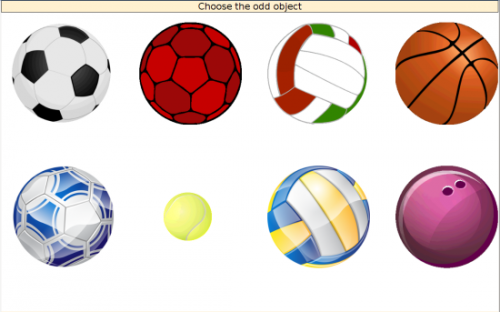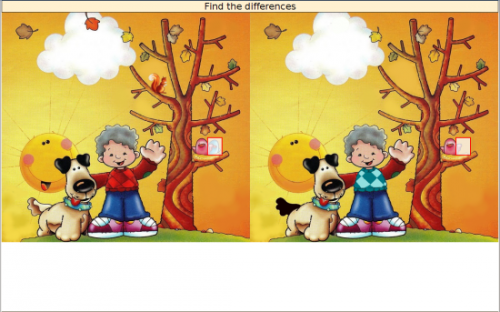Doing APRENDO exercises
From PatioWiki
This section describes how to do the APRENDO exercises and its execution modes.
Contents |
APRENDO modes
APRENDO has two execution modes: Evaluation and Learning. The system responds to the student's actions in a different way depending on the selected mode. The learning mode responds to the user actions telling if the action was right or wrong and the evaluation mode doesn't. Also, the Evaluation mode will generate a log file with the actions that the pupil has done for completing the exercise.
Attentional adaptability
Sound and image matching
This exercise consists in a series of sounds and images. The pupil will hear a sound and then an image will be displayed on the screen. If the image matches the sound, the child has to press on it. Otherwise, the child must not perform any action. If he/she makes a mistake, a wrong action will be recorded. In learning mode, the child will be notified by hearing sounds if his/her action was right or wrong. For the teacher, this task will indicate the child’s matching skills and if he/she is able to refrain from pressing on the image when he/she is not supposed to.
Reaction time
The pupil has to hunt the images that are displayed on the screen. In learning mode, the child will hear a sound when he/she catches the object or makes a mistake.
Teachers will obtain information about the child’s right and wrong clicks and reaction times, so they will be able to evaluate the child’s skills and attention levels when doing the exercise.
Attentional Control
Memory
The pupil has to remember some images that are displayed on the screen for a while. Next, the images will be hidden and then they will be displayed again with an added new one. The child has to press on the new image to do the exercise successfully. In learning mode, the child will be notified by sounds if his/her action is right or wrong. In evaluation mode, pressing on a wrong image will finish the exercise. The teacher will be able to know the child’s memory skills, as well as the time he/she spent searching for the new image and the number of attempts needed.
Choose the odd one
In this exercise, the child has to discriminate objects with different size, colour, and so on from a group of objects that belong to the same domain. In learning mode, the child will be notified by sounds if the chosen objects are right or wrong, while in evaluation mode, pressing on a wrong object will end the exercise. The teacher will be able to know if the child is able to discriminate objects by their properties because he will only have to look the wrong clicks and the time spent looking for different objects.
Attentional Strategy
Differences
The child has to find the differences between the left and the right image. When the child discovers the difference, it will be highlighted in both images. In learning mode, the exercise will play a sound when the child presses over a location that he thinks it is a difference. This sound will indicate if a difference was found or the child has to continue searching for them. The teacher will have a detailed information about hits and misses and the searching strategies followed by the children, showing their attention level.
Objects-Scenes
Some images (objects) are displayed on the right of the screen. The left image contains some apparitions of those images and the child has to find them. When an object is found, it will be highlighted showing the hit. Otherwise, in learning mode, special sound indicating the wrong action will be played.
This exercise will allow the teacher to know the child's ability to differentiate between objects, and his/her sharpness of vision when finding specific objects in the picture.
Others
Inside-Outside
The goal of this exercise is to put the objects with the same concepts inside a closed zone of the image, leaving the different ones outside. In order to achieve this goal, a closed zone is shown on screen and the child has to drag a certain type of objects into it. In learnig mode, right or wrong actions are indicated by playing sounds, so the child can complete the exercise learning from his/her errors.
As for teachers, this exercise allows them to check if the child understands the inside/outside concepts and if he/she can recognize objects of the same kind or colour.
Jigsaw
This exercise consists in solving a jigsaw (an image divided into several pieces which have to fit together again). To do the jigsaw, the child has to drag the pieces into a given area. From the analysis of this exercise, the teacher will be able to evaluate the mental representation that the pupil makes for solving the jigsaw.
Series
The goal of this exercise is to complete a series of elements sorting them by shape, colour and so on. In learning mode, the pupil will receive auditive indicators telling him/her if the object was placed in the correct or incorrect place. If the object is placed in the wrong place, it will go back to its initial position. In learning mode, the exercise will not finish until all the objects are in their places. The teacher can determine the level of knowledge of the child over the elements of the series and also the skill that he/she is able to develop to interpret the meaning of the sequence.
Vocabulary
This exercise consists in associating the sound that is being played with one image from the group of images displayed on the screen by selecting it with a pointer device. After that, the next sound will be played and so on until all the objects have been completed. In the Learning mode, a sound will be played indicating that the selected object was wrong. In the Evaluation mode the wrong action will be registered and the exercise will finish. This exercise will help the teacher to analyze the child’s association between sounds and images, as well as his/her knowledge of the vocabulary of the elements of the domain.
Logs generation
While performing an exercise the system generates a Log file, which stores all the user actions.










